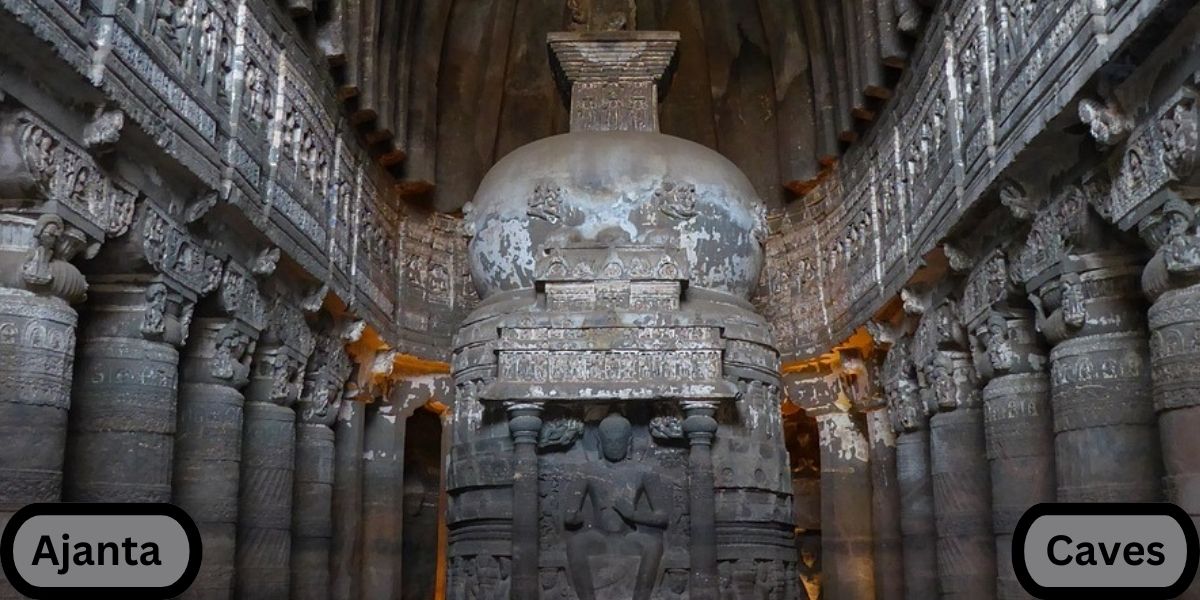Introduction:
Ajanta Caves are located at a distance of 107 km from Chatrapathi Sambhaji Nagar (Aurangabad). An army officer of the British Madras Regiment discovered these caves in 1819 during one of his hunting trips.
According to historians, these caves were built in two phases around 200 BC. (Satavahana period) and 500 AD (Vakataka period). The Ajanta Caves are rock-cut structures on a massive horseshoe-shaped rock near the Waghora River. There are about 31 caves. Each cave is an exquisite architectural marvel with carved pillars and a porch.
Most of the caves are monasteries (Viharas), and some are prayer halls (Chaithya grihas). The monasteries are square, with square sleeping cells attached to them. The monks stayed in monasteries during their journey. The prayer halls for meditation and prayer are narrow and rectangular, with arched ceilings and carved pillars with carved Buddha sculptures. At the end is a large statue of Lord Buddha. The walls and ceilings are decorated with carvings and murals.
The Ajanta Caves have been recognized as a UNESCO World Heritage Site for their cultural importance. Tourists visit the Ajanta caves every year to see the beauty of the sculptures and the famous wall paintings done in fresco technique. These murals are masterpieces of art and examples of remarkable skill.
The artistic brilliance of fresco technique
These murals tell stories and episodes, such as Jataka stories, which convey moral teachings and events from the life of the Buddha. Artists captured the emotions of fellow human beings with extraordinary sophistication. Some paintings have three-dimensional effects with different colors. Some paintings show foreigners, such as Persians, in their typical clothes. The colors were made with natural mineral pigments. A layer of mud plaster is applied to the walls of the cave. Expert artists mix natural pigments with water and apply them to mud plaster. Natural pigments must be applied quickly before the plaster dries and becomes an everlasting masterpiece of art.
Preservation of the Caves
The authorities face significant difficulty in maintaining these caves.Water flow, tree roots encroaching on rocks, and moisture in caves are the main causes of damage. During the rainy season, water flows above the rocks and creates a natural waterfall. Some of the rocks are damaged. In certain caves, the wall paintings are deteriorating. Nearly 75% of the murals have dirt and chemicals on them.
In order to restore several of the murals, Japanese conservation methods were used, along with coatings.
Visiting time of Ajanta caves are from 9 A. M to 5 P.M on all days except Monday.
Conclusion
Ajanta Caves are one of the oldest surviving monuments. Several dynasties, including the Satavahana and the Vakataka, assisted artists during their rule. The structure, which has porches and pillars, consists of monasteries and worship halls. The halls consist of domes on ceilings, carved pillars, and Buddha stupas. The murals depict the spirituality and serenity of Buddhist philosophy and the activities of contemporary people. Scholars and art historians explore these caves to study ancient architecture, sculpture, and art techniques.
Ajanta Caves 10 lines
Ajanta Caves, discovered by a British Madras Regiment officer in 1819, are 107 km from Aurangabad.
The Ajanta Caves, constructed between 200 BC and 500 BC, are rock-cut structures on a massive horseshoe-shaped rock.
Most of the caves are monasteries (Viharas), with square sleeping cells attached to them. The monks stayed in monasteries during their journey.
Prayer halls (Chaithya grihas). are rectangular, narrow, and decorated with arched ceilings, carved pillars with Buddha sculptures, and walls and ceilings adorned with carvings and murals.
The Ajanta Caves, a UNESCO World Heritage Site, attract tourists annually for their stunning sculptures and fresco-style wall paintings, showcasing remarkable artistic skill.
The fresco technique showcases artistic brilliance in murals, conveying moral teachings and events from Buddha’s life, capturing emotions with sophisticated techniques and depicting foreigners.
Expert artists use natural mineral pigments to create colours in cave walls using mud plaster, mixing them with water quickly to create an everlasting masterpiece.
Authorities face challenges in maintaining caves due to water flow, tree roots encroaching on rocks, and moisture in the caves.
The caves showcase Buddhist philosophy’s spirituality and contemporary activities, attracting scholars and art historians to study ancient architecture, sculpture, and art techniques.
Visiting time of Ajanta caves are from 9 A. M to 5 P.M on all days except Monday.
Ajanta cave Timing
Visiting time of Ajanta caves are from 9 A. M to 5 P.M on all days except Monday.
Aurangabad to Ajanta caves distance
107 Km
Shirdi to Ajanta caves distance
155 Km
Jalgaon to Ajanta caves distance
46 Km

